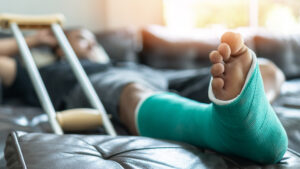
You may view broken bones as minor injuries. Statistics show that half of Americans break a bone before they turn 65.
In many cases, a fracture inconveniences you but does not impact your physical, mental, or financial health. For example, if you broke your arm as a child, you probably healed without complications within six to eight weeks.
But broken bones can cause serious problems. A severe break might require expensive surgeries and physical therapy. Broken bones can keep you from working or even caring for yourself. You might develop complications after breaking a bone, leading to further medical treatment.
What Is the Structure of Your Skeleton?

Your musculoskeletal system includes bones and soft tissues. This system gives structure, strength, and movement to your body.
Your bones provide the scaffolding to hold your body up. They support your weight and give your muscles the leverage they need to help you sit upright, stand, and walk.
Your bones have a matrix of minerals that give them a rigid structure. If you look at bones under a microscope, they appear porous, like a sponge. Blood vessels run through the pores of the spongy bone to deliver oxygen to bone cells. Your bones will die without blood circulation.
The bones also play a role in your circulatory and immune systems. Bone marrow produces new blood cells, including red cells, white cells, and platelets. The new blood cells get added to the blood supply to replace cells removed by the spleen.
How Does Trauma Break Bones?
Bones break when they are subjected to forces that overcome the inherent strength of the bone. These forces can come in many forms, including the following:
Bending Forces
Bending forces are some of the most common causes of broken bones. You can experience bending forces in a car accident when your car gets hit from the side. As your door bends in, it can bend your arm or leg on that side of the vehicle.
Twisting Forces
If your body gets caught, a bone could get twisted forcefully enough to fracture. A twisting force might happen in an industrial accident when a limb gets caught in a machine. The force of a running machine can break the bone and even dislocate your joints.
Crushing Forces
Crushing forces happen when extreme pressure is applied to an area. These forces can shatter a bone into multiple pieces. For example, your foot bones could shatter in a workplace accident in which someone runs over your foot.
Blunt Impacts
A blunt impact happens when you get hit by something that does not leave an open wound. The force of the impact on your body can fracture a bone. A pedestrian accident can result in a fractured femur if a car’s bumper hits your leg.
What Types of Bone Fractures Can Occur?
Doctors classify bone fractures using three criteria. The type of bone fracture you experience will determine your treatment and the possible complications you might develop.
Displaced or Non-Displaced
After a bone breaks, the broken ends might remain aligned. This is called a non-displaced fracture and will usually heal quickly and with few complications.
For example, a stress fracture happens due to overuse. This type of fracture looks like a hairline across an otherwise normal bone because the bone usually does not deform or displace.
The broken ends of the bone can also move out of alignment. This type of break, called a displaced fracture, must be set before doctors can put a cast on it. Setting a displaced fracture means that the doctor must move the ends of the bone back into alignment.
Sometimes, doctors can manipulate the bone externally. But sometimes, the doctor will operate to realign the bone. They may even need to secure the bone with plates and screws.
Open or Closed
A closed fracture happens when you do not suffer an open wound with your broken bone. An open fracture occurs when the broken end of the bone displaces so far that it breaks the skin. As a result, you will see bone protruding through your skin near the break.
Doctors also call an open fracture a “compound fracture.” By definition, a compound fracture is open and displaced. But fractures can be closed and displaced or closed and non-displaced.
The Shape of the Fracture
The shape of the fracture can also determine how it gets classified. A transverse fracture forms a relatively straight line across the axis of the bone. A spiral fracture results from twisting forces and looks like a spiral around the bone.
One of the most serious fractures you can experience is a comminuted fracture. This type of fracture occurs when the bone shatters into at least three pieces. Since one of these pieces will float freely, doctors need to reconstruct the bone surgically.
What Complications Can Result from Broken Bones?
Your broken bones can lead to serious complications, including these:
Infection
An infection happens when pathogens enter the body through an open fracture. The pathogens multiply and make you sick. Your body triggers swelling and fever in response, making you even sicker.
Doctors treat infections using antibiotics. Serious infections might require several rounds of powerful antibiotics.
Nerve Damage
Nerve damage can happen when a fracture displaces. The broken end of the bone can tear muscles, blood vessels, and nerves as it shifts out of place. Doctors can repair some nerves using nerve grafts. But since nerves cannot regenerate, unrepaired nerves will produce permanent numbness, paralysis, and other symptoms.
Pulmonary Embolism
Your body repairs a broken bone by forming a blood clot over the fracture. If a piece of the blood clot breaks off, it can travel to your lungs. A blood clot in your lungs can interfere with your blood getting the oxygen it needs.
A pulmonary embolism deprives you of oxygen. You may suffer permanent lung damage or die without emergency treatment.
What Compensation Can You Pursue for Your Broken Bones?
You can pursue compensation for broken bones sustained in a collision, workplace accident, or other types of accidents. This compensation covers both economic and non-economic losses. Economic damages include medical bills and lost wages. Non-economic damages include pain, suffering, and disability.
When you suffer a broken bone, you may need surgery to reconstruct the bone, followed by a period of rehabilitation.
To discuss your fractured bones and the compensation you can seek for your losses, contact us at Jay Murray Car Accident and Truck Accident Lawyers for a free consultation at (214) 855-1420.
